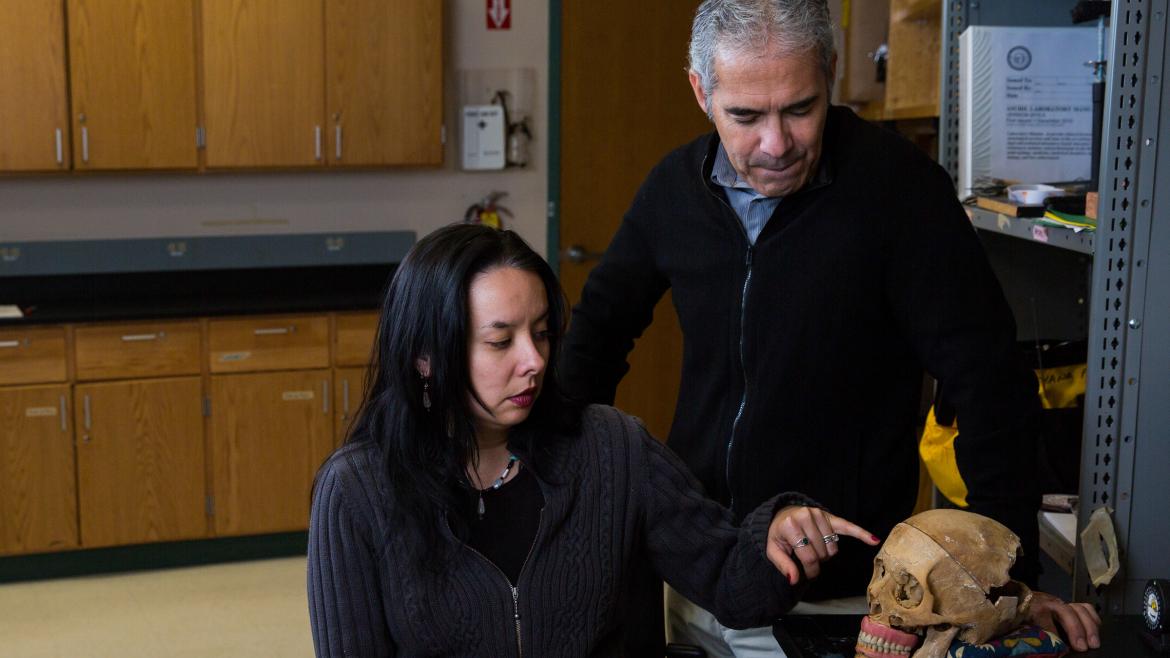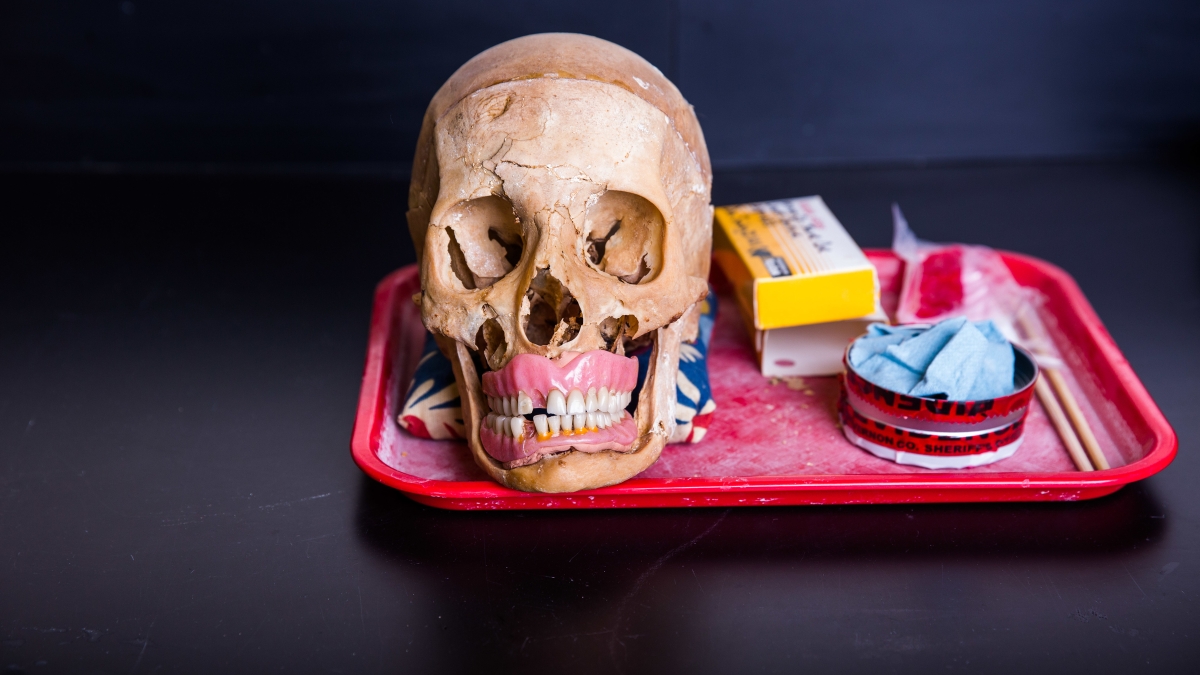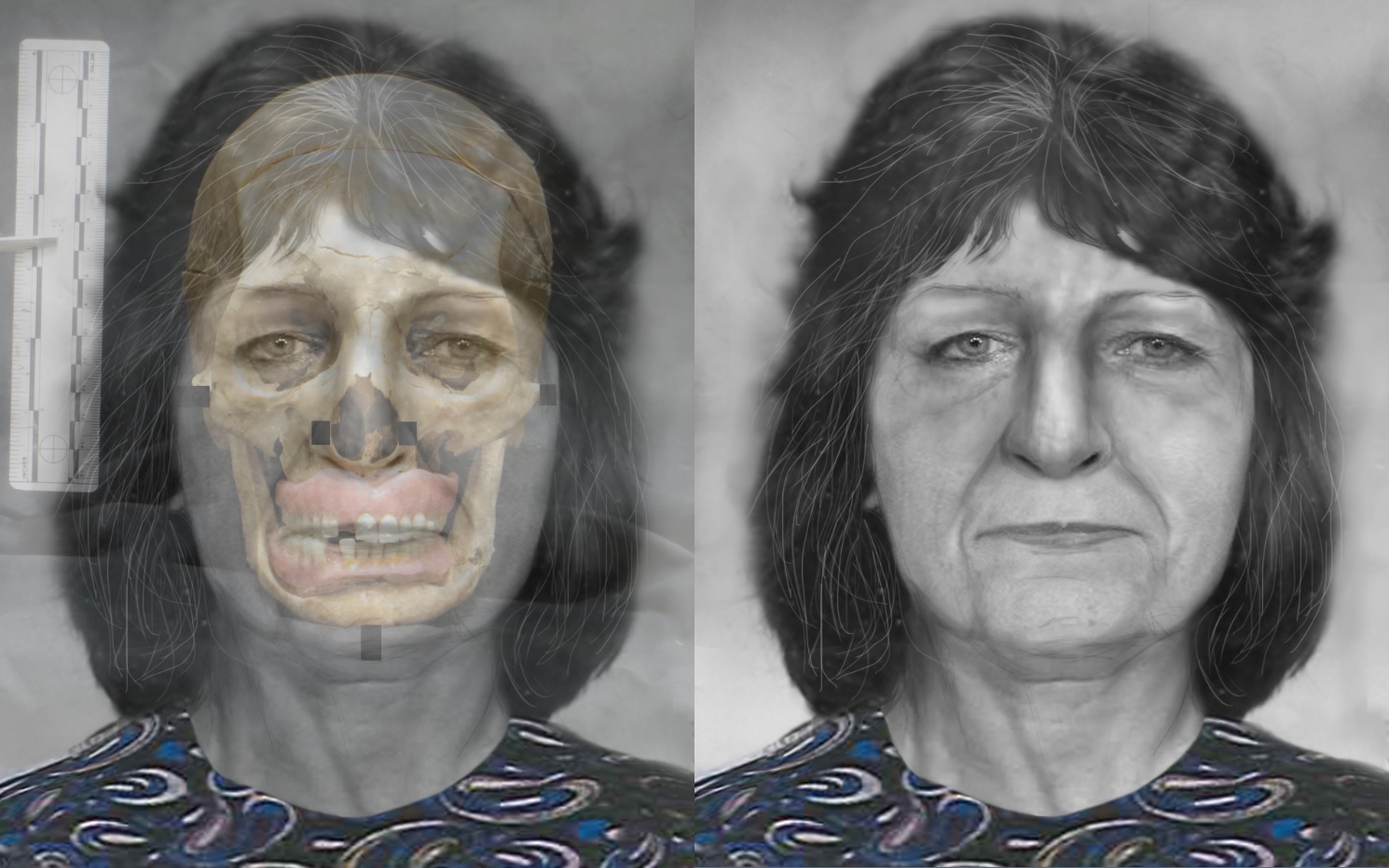Every couple has a “how we met” story. Sometimes it takes place at a party, sometimes it’s online, sometimes it’s at school.
Anthony and Catyana Falsetti met at a morgue in Broward County, Florida.
“She was working for the county sheriff’s office, I was a forensic anthropologist at the University of Florida, and I had been sent to the morgue to identify skeletons,” Anthony explained.
Today, things aren’t much different. Catyana is still working for the county, only now it’s the county of Maricopa, and Anthony is still working as a forensic anthropologistAnthony Falsetti serves as a Professor of Practice in ASU’s School of Mathematical and Natural Sciences, an academic unit of the New College of Interdisciplinary Arts and Sciences on the West campus. for a university, only now it’s Arizona State University.
He and CatyanaCatyana Falsetti works as a forensic artist for the Maricopa County Attorney’s Office. She is also a graduate student at Arizona State University and will be teaching the course “Documenting the Crime Scene” through ASU’s Criminology and Criminal Justice Program at the Downtown Phoenix campus for the fall 2016 semester. — a non-degree graduate student at ASU — are recent Valley transplants, having come to Arizona via the aforementioned “Sunshine State.” The fall 2015 semester was their first at ASU, but they’re already finding plenty to keep them busy.
Beginning with a request to help in the identification of the murder victim of a 1984 cold case from Wisconsin.

Anthony and Catyana Falsetti — he an ASU professor, she a forensic artist who will teach an ASU course this fall — worked together on a skull (also shown in the top photo) from a cold case.
Photos by Deanna Dent/ASU Now
The sheriff’s department in Wisconsin looked to Anthony because of his work in assisting with the creation of NamUs.gov, a first-of-its-kind website launched in 2010 at the behest of the National Institute for Justice to more efficiently identify missing or unidentified persons.
Of which “there are about 50,000 that we know of in the U.S.,” Anthony said.
NamUs.gov uses a dual-sided system that allows for medical examiners, coroners and law enforcement officials to input information regarding missing or unidentified persons on one end, and the general public to input information regarding an individual on the other. Whatever information one side lacks, the other may be able to provide, increasing the chances of resolving cases.
Besides basic stats like age, sex and ethnicity, photos of an individual can also be uploaded to the site. However, in some cases — as with the 1984 Wisconsin homicide victim — because a person’s identity is unknown, so is what he or she looked like.
Thankfully, talented forensic artists like Catyana are able to create 3-D facial reconstructions using the victim’s skull as a basis for adding layers of muscle and skin. With nearly 80 facial reconstructions under her belt and a 10 percent identification success rate (the national average is about 1 percent), enlisting Catyana’s help was essential.
Before she could get started, it was Anthony’s job to prepare the skull, which was badly damaged due to the manner of death. With the help of ASU forensics junior Kori Dowell, Anthony began the first step: maceration, or removal of the remaining soft tissue, at their West campus lab.
Most skulls of individuals who have been deceased for 30-plus years do not have any remaining tissue because of the natural process of decay. However, in this case, the victim had been embalmed before burial, which preserved some of the soft tissue, though not enough to get an accurate idea of what she looked like. Thus, it had to be removed in order for Catyana to be able to build an accurate likeness, as extra tissue on the skull would provide inaccurate measurements of the bones.
The process of maceration consists of submersing the cranium in warm water for a number of days, then removing the tissue from the skull using the appropriate tools.
While the idea may cause some to squirm, Dowell was grateful for the opportunity to get real-life experience.
“I think it is extremely important for students to get hands-on experience so they can learn more about the field and the career in an up-close-and-personal setting,” she said. “Especially in science careers, there are a lot of things that can only be taught and practiced in labs and with experience.”
Removing the tissue also allowed for Anthony and Dowell to make observations about the underlying damage to the skull and evaluate the trauma, which becomes very important in the event a suspect is identified and the case goes to court.
“So [the trauma] noted in 1984, we can corroborate it with what we know now and just give a more clear picture of the level of injury,” Anthony explained, which could determine anything from the level and type of crime an individual is charged with to the length of his or her sentencing.
Anthony and Dowell’s observations of the skull upon removal of the soft tissue noted extensive trauma. So much so that large portions of it had to be superglued together in order for the reconstruction process to begin.
The first step in the reconstruction process was to photograph the skull and upload it to Photoshop. Then, Catyana used tissue depth-marker measurements to layer muscle and skin over the skull.
Tissue depth markers — which refer to the thickness of one’s skin at various points on the human face — vary depending on a person’s ancestry. So depending on the shape of the skull, which Anthony had evaluated and determined to be of European descent, Catyana layered more or less tissue.
The resulting image was the face of a woman in her mid-50s, a strong, thick nose dominating her square-ish face, offset by two downward-tilting eyes, deep smile lines and thin lips.
The completed facial reconstruction of the victim, done by forensic artist Catyana Falsetti. The hairstyle was based on hair found at the scene, and the shirt used in the image was found at the scene as well, Falsetti said.
All that was left to do was to upload it to the unidentified victim’s NamUs profile in hopes that someone would recognize her.
“That’s why the NamUs system is so important, because people can sit on their computer online now and at least search what has been uploaded,” said Catyana.
“That’s what we’re hoping to do here at ASU,” Anthony said, “is to start [creating facial reconstructions] within our own state, then work regionally. We’ve reached out and we’ve got some cooperation from medical examiners. And we’re going to start digitizing actual skulls so that we can then produce 3-D reconstructions based on the new data.”
Using a 3-D laser scanner would not only make the facial reconstruction process more accurate, but would allow for the extraction of even more data “so that we can continue to learn more about the human face and variation,” Anthony said, “which is what all this gets back to, as an anthropologist, is studying human variability. And this is just the application of it.”
More Science and technology

Will this antibiotic work? ASU scientists develop rapid bacterial tests
Bacteria multiply at an astonishing rate, sometimes doubling in number in under four minutes. Imagine a doctor faced with a patient showing severe signs of infection. As they sift through test…

ASU researcher part of team discovering ways to fight drug-resistant bacteria
A new study published in the Science Advances journal featuring Arizona State University researchers has found vulnerabilities in certain strains of bacteria that are antibiotic resistant, just…

ASU student researchers get early, hands-on experience in engineering research
Using computer science to aid endangered species reintroduction, enhance software engineering education and improve semiconductor material performance are just some of the ways Arizona State…

